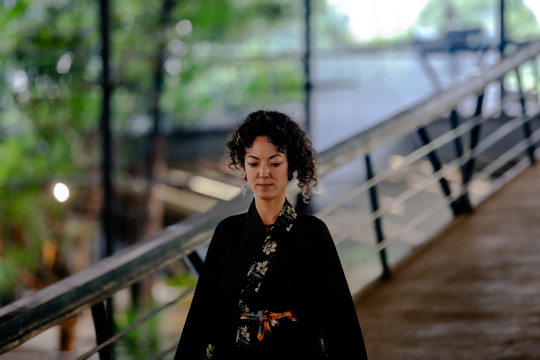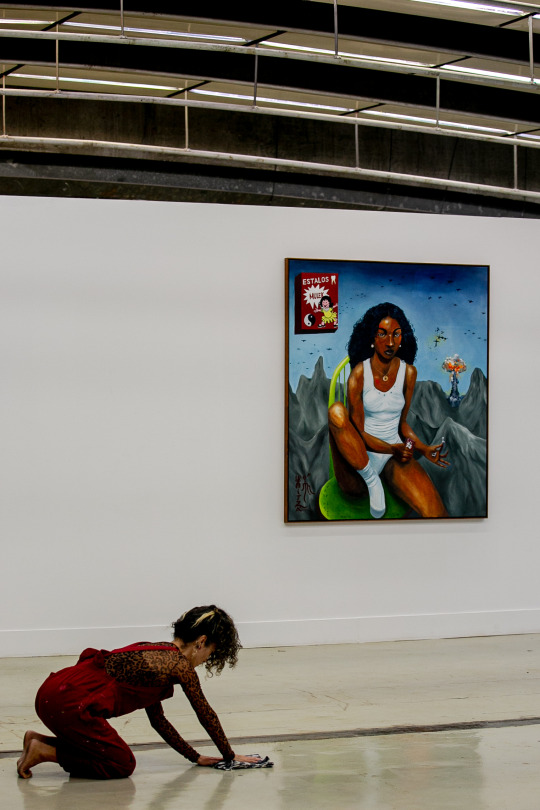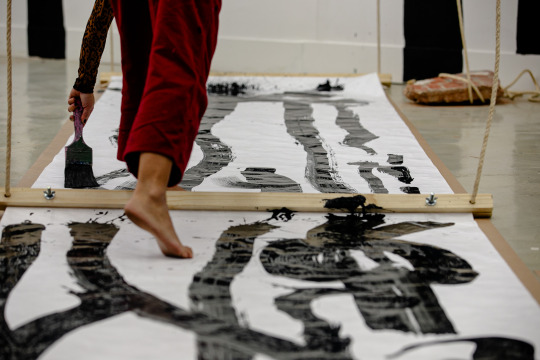#Carolina Itzá
Explore tagged Tumblr posts
Text
Bumba meu boi: memória, ciência e tradição
Bumba meu boi: memória, ciência e tradição
A mestra de cultura popular Bel Carvalho lança “Do auto do nosso boi” sábado (3). Foto: Aline Fernandes. Divulgação A começar pelo título, ao mesmo tempo direto e singelo, “Do auto do nosso boi” (Trança Edições, 2022, 56 p.) soma-se a farta bibliografia (afetiva) existente sobre o bumba meu boi, de longe a mais popular manifestação cultural do Maranhão, patrimônio cultural imaterial da…

View On WordPress
#Aline Fernandes#Andrea Pedro#Bel Carvalho#bumba meu boi#Carolina Itzá#Carolina Von Zuben#ciência#cultura popular#Do auto do nosso boi#Florzinha Carvalho#Grupo Cupuaçu#literatura infantojuvenil#livro#maranhão#música#memória#Nathalia Meyer#Pepê Carvalho#Renata Santos Rente#são paulo#teatro#tião carvalho#tradição#Trança Edições#zeca baleiro
1 note
·
View note
Text















Chichén Itzá is arguably one of the premier sites for encountering pre-colonial archaeological ruins and art in the Americas. There may be other sites of Mayan antiquity in the Yucatan that are better preserved or more tranquil and remote, but no other site is as synonymous with the heights of Mesoamerican culture as Chichén Itzá.
When visiting archaeological sites, one thing to keep in mind is that compromises must be made when restoring the site. Does one restore the site to what archaeologists determine to be its peak condition, such as what was done in the Minoan settlement of Knossos, or do you opt for a more conservative approach and leave the site relatively untouched. A much more modern example of this second approach would be Drayton Hall in South Carolina, which has essentially been preserved in the same condition it was in when it was first acquired in the 1960's.
Chichén Itzá definitely seems to fall into the first category, with extensive reconstruction work done in the 20's and 30's. That being said, later excavation sites, especially those clustered near the observatory, exhibit less restoration work and appear as if they have been freshly uncovered from the tropical jungle. Whether that is a conscious choice or simply a result of insufficient evidence to do a full restoration, I have no clue.
I also doubt I'm the first one to note that Chichén Itzá is loved to death. Traffic is horrendous and me and my mom were spared from the lengthy lines because we bought tickets in advance that provided for expedited entry as we had learned our lesson from going to Tulum a few days earlier. Trinket sellers adorn every path. While I can appreciate the hustle, the number of merchants is excessive to say the least.
So if you desire tranquility and want the thrill of exploring some piece of history few have taken in, then Chichén Itzá is not that place. However, I would advise going at least once as there are few sites in the Americas that have the sheer concentration of well preserved Mayan ruins and architecture as Chichén Itzá does and I am glad I was able to see it with my own eyes and take some pictures for the record.
1 note
·
View note
Text
To be pedantic in return:
We don't know what caused the "classic Mayan collapse", but also the collapse wasn't the end of Mayan civilization by any means. It marked a significant shift away from the center of power. The Mayans still continued to have kingdoms and empires.
Like, Chichén Itzá was partly a post-classic city-state. And the Kʼicheʼ (Quiché) kingdom of Qʼumarkaj was still around by the early 16th century, so was also in the post-classic period.
The Maya people also still exist today, so "what happened to the Maya?" is "well...they're still around?"
Also IS the lost Roanoke colony REALLY a mystery? The word "CRO" and "CROATOAN" was carved into the palisade of their settlement. John White assumed this meant (rather obviously) that this referred to them going to Croatoan Island, where the Croatoans lived.

Roanoke island next to the Croatoan sound.

White therefore assumed that his colony had abandoned the Roanoke Island base, as intended, moving some fifty miles southward to Croatoan, near Cape Hatteras.
Some Croatoans had already visited England.
White also wrote (1590)
I greatly joyed that I had safely found a certain token of their safe being at Croatoan, which is the place where Manteo was born (a croatoan man) and the savages of the island our friends.
Then White wrote:
The next morning it was agreed by the captain and myself, with the master and others to weigh anchor and go for the place at Croatoan where our planters were for that then the wind was good for that place.
They tried to sail to Croatoan, but then a storm hit. They just didn't attempt to sail to Croatoan again after that one storm.
So the mystery, in summary, is:
White and the colony agree they will write out the name of wherever they end up relocating to, as they know they will relocate away from Roanoke. They agreed this is how they would communicate — "agreed upon between them & me..."
White is delayed in his return to Roanoke. He gets there in 1590.
A Croatoan man, Manteo, was the ally of the English colonists, had been to England before, and had introduced some of the Roanoke colonists to the island of Croatoan in 1587.
White finds "CROATOAN" written on the palisade and remarks on his journal that he's glad to have found a sign they (the colony) safely relocated to Croatoan island where they have native allies.
One storm prevents him from getting to Croatoan. Then they never attempt to go to the island again!
Some guy in like, 1701 wrote that the locals of the island stated some of their family were descendents of people who came over under Raleigh.
All archaeological evidence indicates that the colonists of Roanoke did indeed relocate to Croatoan Island, aka Hatteras island. Discoveries have included the famous late 16th century gunlock and the Kendall ring, but also 4 seasons of digging has uncovered significant evidence that the natives in the 1600's "were using European weaponry, iron tools, and wearing pocketwatches," and "—were either living harmoniously with Europeans or had become assimilated with Europeans." (coastal Carolina Indians)
Hm. Mystery. Whatever could've happened to the people who stated exactly where they were going as agreed upon?
When it comes to historical and archaeological evidence this is about as definitive as it gets. We have primary sources detailing friendship with native people of that island, confirmation that the message left was an indication of the location of their settlement as previously agreed on, AND that there was no agreed on distress sign, all the archaeological records corroborate the people on this island having clearly European goods likely by way of trade, cohabitation, or assimilation, and we have a later, secondary source saying he found Native Americans on the island wearing English clothes, who had grey eyes, and who said they (their ancestors) came on Sir Walter Raleigh's ship.
Sorry the Roanoke one drives me nuts, haha. It's like a perfect case study of how popular culture distorts known history.
Saw a friend post a meme about Eoster being the source of Easter and CORRECTING it to say that the source was ACTUALLY Ishtar, and I want you to know that the noise I made was inhuman, darlings.
2K notes
·
View notes
Photo

Biblioteca Dr. Enrique Barocio Barrios de Cancún. Tiene el agrado de invitarle a: La exposición de ilustraciones de una nueva creación. "El encuentro de la Mariquita y el niño de los cabellos dorados" Un cuento infantil realizado en Italia por la ilustradora chilena y educadora cultural Patty Carolina y la pedagogista y educadora italiana Rosita Pavese. Expo ilustración infantil. Biblioteca Dr. Enrique Barocio Barrios Av. Chichen Itzá, S/N, Zona Escolar, 77500 Cancún Quintana Roo. Desde el día 8 al 10 de Noviembre de 2022 (en Biblioteca Pública Dr. Enrique Barocio Barrios) https://www.instagram.com/p/CktKNPEOwku/?igshid=NGJjMDIxMWI=
0 notes
Photo

Um dos primeiros projetos da editora, Úrsula, de Maria Firmina dos Reis, é um marco da nossa literatura. É o primeiro romance publicado por uma mulher. Primeiro romance publicado por uma mulher negra. Primeiro romance abolicionista publicado. 👏🏿👏🏿👏🏿 A nossa edição conta com revisão crítica da doutoranda em Literatura pela UFRGS Roberta Flores Pedroso, especialista na obra. Confere nessa entrevista da nossa CEO Fernanda Bastos como foi a produção do livro. 🤩📚📖📜 #Repost @revista_firminas • • • • • • NOVAS EDIÇÕES DE "ÚRSULA" #1Firminas Fundada em 2018 por duas pessoas negras e com um corpo diretivo inteiramente formado por pessoas negras, a Figura de Linguagem é uma editora independente, com sede em Porto Alegre. Em 2018, ela lançou a 15ª edição de "Úrsula" - que só naquele ano ganhou dez novas edições -, sendo duas delas em formato apenas digital. Destas dez novas edições de "Úrsula", cinco foram lançadas por editoras de Porto Alegre. A Firminas entrevistou a diretora geral dessa editora incrível. 📑 Convidamos você a ler conosco a entrevista de Fernanda Bastos "...Então por que publicas? . Link na bio . Diagramação entrevista: Érica Rodrigues . Arte #1: Carolina Itzá 🌐 #RevistaFirminas #Úrsula #MariaFirminadosReis #Entrevistas #Capa #memorialdemariafirminadosreis https://www.instagram.com/p/CEU3O-PHAsp/?igshid=9u3d0fng84t3
#repost#1firminas#1#revistafirminas#úrsula#mariafirminadosreis#entrevistas#capa#memorialdemariafirminadosreis
0 notes
Photo

“Si eres una mujer fuerte protégete de las alimañas que querrán almorzar tu corazón. Ellas usan todos los disfraces de los carnavales de la tierra: se visten como culpas, como oportunidades, como precios que hay que pagar. Te hurgan el alma; meten el barreno de sus miradas o sus llantos hasta lo más profundo del magma de tu esencia no para alumbrarse con tu fuego sino para apagar la pasión la erudición de tus fantasías.Si eres una mujer fuerte tienes que saber que el aire que te nutre acarrea también parásitos, moscardones, menudos insectos que buscarán alojarse en tu sangre y nutrirse de cuanto es sólido y grande en ti.No pierdas la compasión, pero témele a cuanto conduzca a negarte la palabra, a esconder quién eres, lo que te obligue a ablandarte y te prometa un reino terrestre a cambio de la sonrisa complaciente.Si eres una mujer fuerte prepárate para la batalla: aprende a estar sola a dormir en la más absoluta oscuridad sin miedo a que nadie te tire sogas cuando ruja la tormenta a nadar contra corriente.Entrénate en los oficios de la reflexión y el intelecto Lee, hazte el amor a ti misma, construye tu castillo rodealo de fosos profundos pero hazle anchas puertas y ventanasEs menester que cultives enormes amistades que quienes te rodean y quieran sepan lo que eres que te hagas un círculo de hogueras y enciendas en el centro de tu habitación una estufa siempre ardiente donde se mantenga el hervor de tus sueños.Si eres una mujer fuerte protégete con palabras y árboles e invoca la memoria de mujeres antiguas.Haz de saber que eres un campo magnético hacia el que viajarán aullando los clavos herrumbados y el oxido mortal de todos los naufragios. Ampara, pero ampárate primero Guarda las distancias Constrúyete. Cuidate Atesora tu poder Defiéndelo Hazlo por ti
Te lo pido en nombre de todas nosotras“
(”Consejos para una mujer fuerte”, Gioconda Belli)
arte: Carolina Teixeira (”Itzá”)
0 notes


